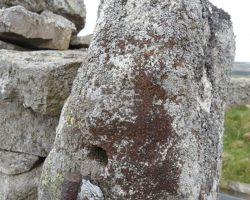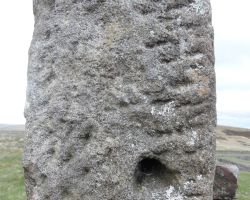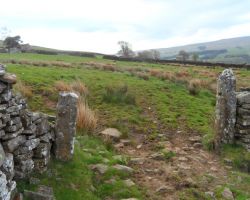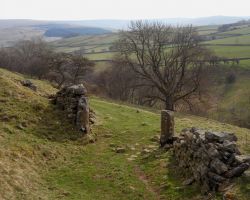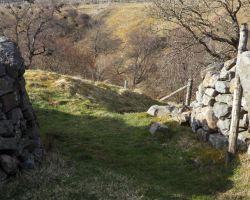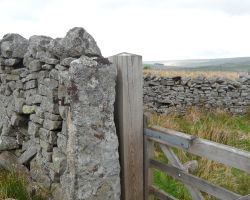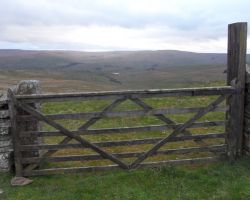Weardale’s beautiful sandstone gate posts were quarried, hand chiseled and set in place when labour was cheap, and when gate widths were determined by the needs of horse drawn vehicles. (The English farm gate width had been set at six feet based on the width of the English farm cart, which in turn had the same wheelbase as the Roman cart, as can be found from worn grooves in old Roman roads).
Bulky and heavy, these sandstone posts came from local quarries which quite often in Weardale can be seen above the farm head dyke, where the stone for the walls was quarried. Sandstone was favoured over limestone as it was easier to work. The gate fittings were secured either to through-bolts (which passed right through the gatepost) or more usually in holes drilled part way through the post where they were held in place by pouring molten lead around the shank of the fitting. When post fittings were damaged the securing lead had to be removed using a blow torch and the new fittings set in place using a roughly fashioned clay funnel fixed to the post.
After World War Two Britain moved into the motor age but still the two most popular farm vehicles, the Landrover and the Grey Fergie tractor, could go through a six foot gate. Then, in the 1970s, these traditional gateways became a problem as field gates now needed to be at least 8 foot wide to accommodate larger tractors and farm implements. Some of the stone posts were broken and replaced when hit by trailers and implements but in many cases the hinge bearing post was simply pulled out to allow the gateway to be widened and then replaced in wood. The return post was left in place because the gate could still be secured to it with wire or rope even if its fittings were broken. In other cases a new large gate was put in a new section of wall and the old gate built back into the wall.
The saddest sandstone gate posts are those which once divided farms along small tracks or which divided fields but became redundant as poor profitability caused Weardale farms to amalgamate and made the repairing of crumbling field walls no longer economic. Now often standing at rakish angles, broken and weathered, and often no longer attached to a wall, these old gate posts are a reminder that upland farming was once profitable enough to warrant enclosing land and that small Weardale farms, their farmhouses now abandoned, could support a farmer and his family. Our photographs aim to show the melancholy beauty of these old gate posts, stranded and useless, but enduring in the beautiful Weardale landscape. (Please send us your similar photos).
